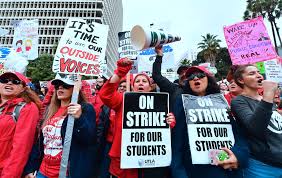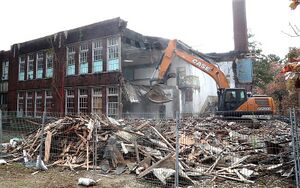Group 2
In May 2048, public high schools in Toronto began to be torn down and were replaced by public housing as a result of the Schools-into-Housing Act, which attempted to mitigate the housing crisis. Since September of 2048, all high school students have been learning remotely, online.
Prelude
After decades of inflation, immigration, rising house prices and increased homelessness, a series of protests and riots erupted across Toronto and the GTA, beginning in the fall of 2046. These protests were primarily headed by university students and young adults who felt as though their wages were not livable, and as though they would never be able to afford a home. Initially, the protests were peaceful demonstrations outside of City Hall and other governmental buildings, but they soon escalated into riots after a controversial press conference given by Mayor Vanessa Byrd on September 14th, 2046 in which she stated that “people who work hard can make their living”, a statement which she would later claim was taken out of context. After this press conference, the protests turned violent, with many protesters blocking traffic and attempting to storm into City Hall. This in turn precipitated a significant police response, which resulted in several violent exchanges between both factions. Although no one was killed during the conflicts, many protesters reported injuries ranging from bruises to broken limbs. After six months of riots, Mayor Byrd resigned, but this did little to quell the insurrection. Meanwhile, the protests inspired similar movements in Vancouver and Montreal, the other two cities which were most affected by the housing crisis. These protests did not turn violent, possibly because their municipal governments did not espouse views similar to Byrd’s.
Shortly after Byrd’s resignation, Prime Minister Daniel Marsden announced that he would work closely with the Premiers of Ontario, British Columbia and Quebec to find an amenable solution to the housing crisis. Three months later, Marsden would propose the Home Buyer’s Rebate, a stimulus check of $1,000 per person over the age of 25 who did not own a home, but the idea was not warmly received by the Canadian population nor the Official Opposition. The protests, which had begun to die down, saw a sudden resurgence, leading once again to recurring clashes between protesters and police. Marsden faced internal pressure to resign, but he remained in office and publicly swore that he would find a solution to the housing crisis before he left office.
In early September 2047, nearly a year after the protests began, Marsden proposed Bill 325 SHA: The Schools-into-Housing Act, an idea credited to longtime virtual education proponent, Ontario Minister of Education Evelyn Chang. As explained via an interview with the ICBC, this bill would see all public high schools in Toronto torn down and replaced with affordable, government subsidized housing; meanwhile, high school instruction would be provided virtually over the approved applications CanComm and Microsoft Classroom, which had been developed years prior precisely for online teaching. While teachers’ unions and organizations opposed Bill 325, the response from the general public and most other organizations was largely positive, with many parents agreeing with the sentiment that “our kids won’t lose anything by going to school online.” The municipal governments of Vancouver and Montreal would also laud the bill and begin lobbying for it as well. Teachers’ unions and organizations had initially planned to strike over the bill, but ultimately relented when it became apparent that public opinion would be against them. Finally, by the end of April 2048, Bill 325 was approved and work on tearing down Toronto’s high schools began.
Implementation
Bill 325 SHA - The Schools-into-Housing Act was seen as a way to mitigate the rising homelessness crisis within Ontario, especially since the increase in the population was straining government systems. The Canadian government’s plan to implement this bill was first to survey the areas to determine which schools would be torn down to build affordable housing. The surveying of areas took the most time as it required considering certain factors, such as area density (How many people are living within a specific area), spatial space (If there was enough space to build), and impacts on the community. The plan initially proposed that some schools be torn down and converted into housing; however, from the surveyor’s data, the reports indicated that the area density was too high and tearing down some schools would not mitigate the homelessness crisis. There were too many homeless individuals in an area, and surveyors concluded that tearing down some public high schools would not decrease that number. As such, the Bill was modified to include all public high schools to be torn down as it would offer the solution to the ever-growing issue and accommodate the majority of homeless individuals.
Moreover, according to surveyors’ reports, schools took roughly 45% of spatial space in relation to the overall space within a specific community area, with 35% being high schools and 10% being elementary schools. The other percentages were residential, commercial, and industrial buildings. By tearing down high schools and building housing, 35% of the space that they occupied would increase residential building capacity to accommodate the high increase of homeless individuals. Reports also indicated that one school’s spatial space can accommodate 15% of the homeless individuals living within the community. With all the schools torn down, it can house 100% of these individuals and even have some space to accommodate others. The report on spatial space was one of the deciding factors by which the Canadian Parliament decided to push the Bill to pass and implement it first within Ontario.
After the Canadian Parliament passed Bill 325 - SHA, the next step was to notify the community and the students on how to proceed with education. Before tearing down schools, the government held various programs and outreach to inform the community on how teaching and student learning would occur in homes. Given that resources were already created for at-home learning due to the pandemic in the year 2020, the transition from in-person learning to at-home learning proved to be smoother than expected. However, some argue it could have been a smoother transition as teachers needed proper training in teaching students using this method. Protests erupted both from teacher unions and other community members against the Bill. However, despite their protests, the Bill moved forward, and both teachers and community members were forced to adjust to these changes. As a result, private school enrollment reached its capacity as these schools were exempted from the bill since the government did not publicly fund them.
Once the communities were informed of how education would proceed, schools were torn down to begin building new housing. The projected time to tear down and build these buildings is 15 years. However, Parliament urged that the tearing down and building must be prioritized and take less time if possible. As such, this urgency helped slightly with the economy as construction companies needed more individuals, thus creating jobs. Although there was an increase in the saturation of construction workers, the funding these companies received could not adjust the pay these workers should have been paid. However, because the homelessness crisis heavily strained the Canadian economy, individuals took these construction jobs because they provided some income for them. With the increased labour, the projected timeline was reduced from 15 to 7 years. As the construction began, the public high schools in downtown Toronto were torn down first. They would then start tearing down schools as the projects in downtown Toronto were completed, working their way towards the suburbs and then further schools away from the cities until they were all converted into affordable housing.
A few months before the demolition of public high schools, the Boards of Education in Ontario implemented a revised version of at-home learning based on the plans for the 2020 COVID-19 years. This revised educational method introduced what is now called “Virtual High School Learning.” As the name suggests, this schooling method allows high school students to learn from home using their electronic devices and online platforms such as CanComm and Microsoft Classroom. However, with the advancement of technology, many have indicated that virtual reality would soon be an option. The Canadian Parliament, in accordance with the Ministry of Education, has argued that virtual learning is the most effective method to teach high school students. However, critics have had their fair share of opinions regarding this method, especially concerning students’ mental health and the effects on teachers.
As Virtual High School Learning was implemented, students and teachers had difficulties adjusting to this method of learning and teaching, which were reflected in the student assessments. Reports from various school boards indicated that student grades fell by 30% compared to when they were in-person. With this decline, school boards invested more into training teachers to better teach and support their students. This investment allowed teachers to receive the support and resources they desperately needed, consequently permitting them to find innovative and creative methods for teaching. With support, teachers could adapt and adjust their teaching styles to accommodate the restrictions of virtual learning leading to an increase in students' grades. Over time, reports later indicated that students did better through virtual learning compared to in-person learning.
Despite the criticisms after the Bill was passed, virtual learning became the superior teaching and learning method. Not only were teachers better supported, students also excelled in their academics because of the support their teachers received, allowing for more interactive teaching styles and methods. Furthermore, reports have indicated that homeless individuals and low-income families benefitted from virtual learning as, through this method, parents were able to be more involved with their children and their education. As parents became more involved, students felt supported and guided, resulting in better grades and the overall quality of their work. Despite seeing a 30% decrease in student grades when the Bill was first implemented, this figure has been constantly rising, reaching a 57% increase, which will continue according to data forecasts.
Education
Impacts on Teachers
In September 2047, when Bill 325 - SHA was first proposed, teacher unions were opposed to the suggested shift to virtual learning. Their main concern was lack of preparation and insufficient training. The Ontario Secondary School Teachers' Federation (OSSTF) was the most vocal with their opposition, making statements that argued that the transition was too rushed, and that it would leave teachers unprepared unless proper training and resources were provided. Another concern the OSSTF cited was the negative impacts virtual learning would have on students, especially since data collected in the aftermath of the COVID-19 pandemic suggested a rise in mental health struggles due to the more isolated form of education. Despite their protests, the federal and provincial government went through with their plans.
In order to have an easier transition, the municipal government put in place a variety of support systems and outreach programs. The TDSB specifically offered a variety of free seminars and training sessions to better prepare teachers who needed the extra support. The voluntary surveys received as feedback for programs were largely positive, and many agreed that it was helpful, although there were still plenty of obstacles teachers faced at the start of the academic year. When Bill 325 went into effect in September 2048, the impact on Toronto's teachers was significant. The switch to a fully digital public education system reshaped the profession, especially when it came to pedagogical expectations. Teachers were forced to adapt to new methods of instruction, in addition to learning how to best manage their much larger classes. With the sudden closure of school buildings, educators were required to become proficient in various digital platforms and tools, such as CanComm and Microsoft Classroom.
As a response to this new way of approaching classroom management, qualified teachers began to leave the profession, especially those nearing retirement. The shortage in teachers was a big concern for public school boards. The TDSB even brought back the Emergency Placements Persons (ERP) position, which had initially been introduced in 2020, and allowed unqualified individuals to act as substitute teachers in the event that a certified educator was unavailable. This also led to significant increases in class sizes. Without the constraints of physical classrooms, and because of the teacher shortages, the province opted to enroll larger numbers of students in each virtual session. This dramatic increase in student numbers (anywhere from 50-100) made it more difficult for educators to provide individualized attention and support to students. While teachers were actively going to workshops to make their classrooms more engaging by using a ludic approach, it was still difficult for teachers to accurately evaluate individual student needs.
The shift to virtual learning in high schools following their shutdown in the city of Toronto had a significant and lasting impact on teachers. The universities with the largest education programs were quick to implement a variety of new courses to help graduating secondary teachers, but many who were experienced in the field struggled to adapt. There are plenty of lesson plans from the time that showcase the attempts, or lack thereof, to create a positive learning experience for students. While the shift began as something teachers fought against, they had no choice but to accept in the face of the housing crisis, and many ultimately thrived in their new educational reality. Virtual secondary classrooms shaped the education landscape, and would not just affect teachers, but students as well.
Impacts on Students
The shift to online school for high school students happened quickly and with very few technological issues, as schools had already begun incorporating online learning for the past few decades. High school students, having grown up in an age of technological advancement had become accustomed to using online learning platforms; however, the switch to completely full-time online learning created new barriers for learning that teachers, especially those that had spent a majority of their career in in person classes, were not prepared to address. Thus, the first couple of years of the implementation of online school were defined by a string of trial and error in the education system.
During the first few years of the switch to online school, engaging students was a major issue. Students reported being more easily distracted when learning online. Although online learning platforms took measures to prevent distractions like browser locking technology on learning devices ; other personal electronic devices could not be controlled. Furthermore, the increase in class sizes due to the shortage in teachers made monitoring student attention a difficult task. In a Found Journal from 2048, a grade 10 student recounts her classmate leaving their workspace for an entire period and going unnoticed by her teacher. As a result of lack of engagement, academic performance in Toronto’s public board decreased drastically. As private schools were unaffected by the shift, the gap in university enrolment between students from the public board and students from the private board increased and as did failure rates for first year university students from Toronto.
However, within a couple of years, teachers adapted and created ways to overcome the barrier of online learning. New curriculum was created, and new teachers were trained within the context of full-time online school. Students too, adapted to the online format. Parents, having seen the success of Bill 325 SHA in reducing homelessness in the city, encouraged their children to accept the change and do the best they can to learn online. That being said, many parents, who could afford it, transferred their children into private schools. Enrolling into these schools, thus, had become and remained even more competitive and expensive.
Another impact on student life was the lack of opportunities for student socialization, which is integral to their development. During the start of the shift to online schooling, the board attempted to mitigate the expected negative social effects of online school by allowing students to attend online class sessions in a “buddy system”. This reduced feelings of isolation for some; while, others could not host others or go to other people's homes during school hours for various reasons like lack of transportation, lack of space, social difficulties, and conflicts in the family.
While extra curricular activities were not canceled amidst the shift to online learning, the shortage in teachers and the lack of common space significantly reduced the number of clubs and sports teams in Toronto’s public board. As the school’s tracks and fields were replaced by housing, finding terrain in which student athletes could practice became difficult. In 2048, when the switch had finally been implemented school sports teams were allotted training spaces in community center fields and parks based on performance, meaning weaker performing schools would not have anywhere to practice. This competitive system strongly upset students, and was abandoned from September 2049, forward. Currently, practice spaces are distributed evenly between all schools, even if that only allows for some teams to practice twice a week. Some clubs, like creative writing, debate teams, chess clubs, and others, that could be held online and in different locations survived the shift, although there remained a strong preference for in person activities; however, similarly to sports teams, finding a location to host these events was a problem, especially during colder months.
The shift to online learning for high school students lead to a large increase in social activity after school hours for many students. Students congregate in large groups in parking lots, malls, parkettes, cafes and at each other’s homes. Furthermore, as these congregations were done so privately, some students were completely excluded, a consequence that could not be regulated by the school board. During the colder months of the winter, students were physically unable to spend time together in large groups, and these periods are often marked by reports of poor mental health by students.
Images Used
OpenAI. (2024). ChatGPT (Nov 30 version) [Large language model]. https://chat.openai.com



